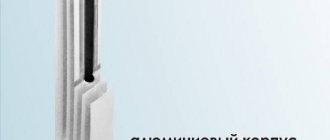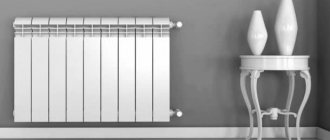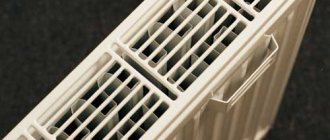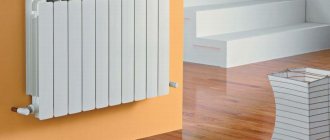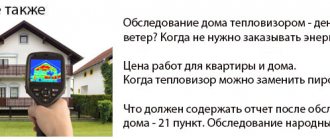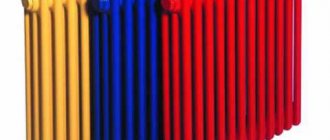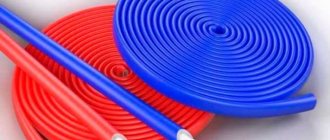A bimetallic radiator is a heating device in which coolant circulates through a steel core placed inside an aluminum casing. Batteries of this type belong to sectional heating devices and operate on the principle of combined (convective and radiant) heat exchange.
The technical characteristics of bimetallic heating radiators include a number of parameters and design features that allow you to evaluate the heating device and compare it with other models of a similar size.
How to correctly compare bimetallic radiators with each other?
Anyone who carefully approaches the choice of heating batteries for their home or apartment strives to purchase products with optimal performance and technical characteristics. To correctly select the most suitable radiator, the models being compared must be of the same size. In the reference data, the parameters are given for one section, so you need to compare not the devices as a whole, but their structural parts. The main parameter by which the division into standard sizes occurs is the interaxle distance.
Radiators with different center distances.
The center distance is the size between the axis of the upper and lower collector. Like all-aluminum models, bimetallic heating radiators are mainly produced with a center distance from 200 to 800 mm. Models with a large center distance, and as a consequence, with an increased section height (but a smaller width of the entire radiator), are rare. They are used if the interior features of the room do not allow placing a horizontally located device.
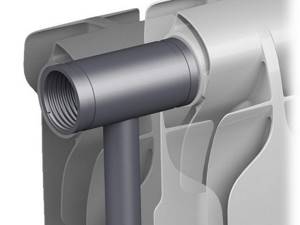
The device of a bimetallic radiator.
Geometric parameters
The main geometric characteristics of a bimetallic radiator are its height, as well as the width and depth of the section. The height, as a rule, is 60 - 80 mm higher than its center distance.
Most manufacturers produce models with a section width of 80 mm. Knowing the number of sections, you can easily determine the total width of the device.
The depth of the section is 80 – 100 mm. The radiator can be either constant depth or varying in height, like the stylish and elegant DreamLiner series device from Royal Thermo.
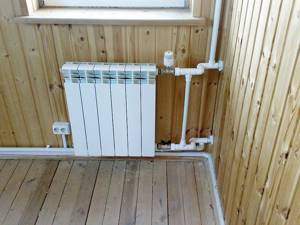
Installation of a heating radiator on a wooden wall.
Thermal power
This parameter allows you to determine how many radiator sections of a particular model are needed to heat a room of a certain area. Thermal power is measured in Watts and is at an interaxial distance:
- 500 mm – from 170 to 200 W;
- 350 mm – from 120 to 140 W;
- 300 mm – from 100 to 145 W;
- 200 mm – about 100 W.
In their information and technical materials (instructions, manuals, catalogs), manufacturers indicate tables showing the number of sections optimal for heating rooms of various sizes.
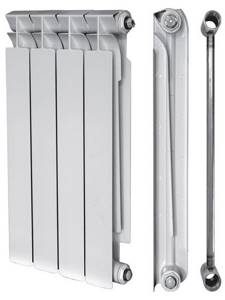
The steel core is the basis of the structure.
Volume (capacity) of one section
In bimetallic radiators, coolant circulates through steel cores. The core is an H-shaped welded structure consisting of an upper and lower collector connected to each other by a vertical tube (heat pipe). Each manifold has two side holes with internal threads, thanks to which the sections can be connected using steel nipples. This design completely eliminates contact of the coolant with aluminum.
Unlike aluminum radiators, where the heat pipe has an oval cross-section, the steel cores of bimetallic models use exclusively round tubes, which provides for a smaller capacity of each section. Thus, the bimetallic Rifar Base 500 has a section capacity of 0.20 liters, while the aluminum Rifar Alum 500 model of the same size has a volume of 0.27 liters.
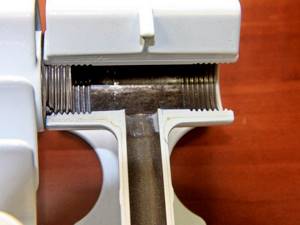
Section of the device in section.
Section weight
Bimetallic radiators have more mass than similar models of aluminum radiators. This is explained by the use of steel cores in their design, the density of which (and therefore the mass) exceeds that of aluminum. For example, the bimetallic radiator Varmega Bimega 500/80 weighs 1.75 kg, and the aluminum radiator Almega 500/80 from the same manufacturer weighs 1.2 kg.
Pressure
The operating pressure of bimetallic radiators is 16 – 40 atm (1.6 – 4.0 MPa). According to regulatory documents, devices must be tested by pressure testing the heating system with a pressure 1.5 times higher than the operating value. The documentation also indicates the value of the maximum pressure, upon reaching which it can begin to collapse.
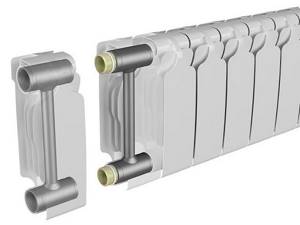
Connection of sections.
Recommendations for selection
Let's summarize. To make the right choice, you must pay attention to all of the following characteristics:
- Design. For a city apartment, a monolithic, fully bimetallic battery is suitable, which can withstand pressure up to 15 atmospheres or more (usually in apartments a pressure of around 12 atmospheres is used, while in a private house it is recommended to set the pressure to just one atmosphere). Cheaper models are suitable for autonomous heating systems, since they do not have high pressure.
- Size. If the distance between the floor and the window sill is at least 80 centimeters, you should choose the highest model. Otherwise, you will have to take a smaller radiator, so that it is at least 12 cm to the floor, and at least 10 cm to the window sill.
- Capacity. One of the main properties is rather narrow passages. If possible, ensure good quality water supplied to the heating system.
- Calculation of sections. Before purchasing, read the model description to clarify the energy capacity. It is better to calculate the number of sections using the second (detailed) formula, where the required amount of heat is determined based on the volume of the room. Do not forget to add 10% in case of significant heat loss due to external factors.
Today, bimetallic batteries from Italian manufacturers Fondital and Global have proven themselves well.
Video on the topic:
Comparative technical characteristics of bimetallic radiators
For convenient comparison of different models, tables 1-3 contain data on the main characteristics of products from 11 manufacturers. The information is provided both for the most common standard size of 500 mm, and for radiators with center distances of 350, 300 and 200 mm, which are present in the model range of only some manufacturers.
Table 1 - Comparison of characteristics of models with an interaxial distance of 500 mm.
| Manufacturer and model | Overall dimensions, mm | Section volume, l | Section weight, kg | Pressure, atm | Thermal power, W | |||
| height | width | depth | working | test | ||||
| Bilux plus R500 | 563 | 80 | 85 | 0,21 | 1,82 | 20 | 30 | 182 |
| Industry Pasotti Elegance Wave Bimetallico | 565 | 80 | 100 | 0,19 | 2,06 | 35 | 52 | 176 |
| Global Style Extra 500 | 566 | 81 | 80 | 0,21 | 1,87 | 35 | 52,5 | 170,7 |
| Conner Bimetal 80/500 | 563 | 80 | 80 | 0,40 | 2,18 | 30 | 45 | 190 |
| Rifar Base 500 | 570 | 79 | 100 | 0,20 | 1,92 | 20 | 30 | 204 |
| Royal Thermo BiLiner 500 | 574 | 80 | 87 | 0,205 | 2,01 | 30 | 45 | 171 |
| Tenrad BM500 | 550 | 80 | 75 | 0,22 | 1,45 | 24 | 36 | 161 |
| Varmega Bimega 500/80 | 565 | 80 | 80 | 0,3 | 1,75 | 30 | 45 | 190 |
| Santekhprom RBS-500 | 560 | 80 | 95 | 0,23 | 2,34 | 16 | 24 | 185 |
| Sira Industry RS Bimetal 500 | 572 | 80 | 95 | 0,199 | 2,03 | 40 | 60 | 201 |
| Scola JB-SA 500 | 565 | 78 | 80 | 0,28 | 1,85 | 30 | 40 | 188 |
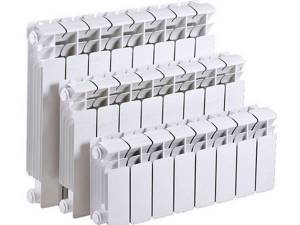
Variety of standard sizes.
Table 2 - Comparison of characteristics of models with an interaxle distance of 350 mm.
| Manufacturer and model | Overall dimensions, mm | Section volume, l | Section weight, kg | Pressure, atm | Thermal power, W | |||
| height | width | depth | working | test | ||||
| Global Style Extra 350 | 416 | 81 | 80 | 0,17 | 1,42 | 35 | 52.5 | 119.6 |
| Conner Bimetal 80/350 | 413 | 80 | 80 | 0,30 | 1,28 | 30 | 45 | 140 |
| Rifar Base 350 | 415 | 80 | 90 | 0,18 | 1,36 | 20 | 30 | 136 |
| Royal Thermo BiLiner 350 | 424 | 80 | 87 | 0,175 | 1,52 | 30 | 45 | 118 |
| Tenrad BM350 | 400 | 80 | 75 | 0,15 | 1,18 | 24 | 36 | 120 |
| Varmega Bimega 350/80 | 412 | 80 | 80 | 0,22 | 1,43 | 30 | 45 | 140 |
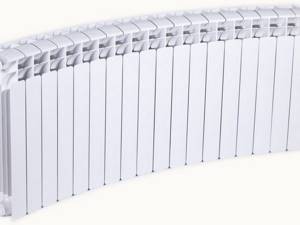
Curved radiator for bay windows.
Table 3 - Technical characteristics of bimetallic radiators with center distances of 300 and 200 mm.
| Manufacturer and model | Overall dimensions, mm | Section volume, l | Section weight, kg | Pressure, atm | Thermal power, W | |||
| height | width | depth | working | test | ||||
| Center distance 300 mm | ||||||||
| Bilux plus R300 | 365 | 80 | 85 | 0,17 | 1,29 | 20 | 30 | 142 |
| Santekhprom RBS-300 | 360 | 80 | 95 | 0,178 | 1,67 | 16 | 24 | 121 |
| Sira Industry RS Bimetal 300 | 372 | 80 | 95 | 0,165 | — | 40 | 60 | 145 |
| Scola JB-SA 300 | 365 | 78 | 80 | — | 1,45 | 30 | 40 | 106 |
| Center distance 200 mm | ||||||||
| Bilux plus R200 | 550 | 80 | 75 | 0,22 | 1,45 | 24 | 36 | 161 |
| Rifar Base 200 | 565 | 80 | 80 | 0,3 | 1,75 | 30 | 45 | 190 |
Advantages of Rifar Base 500 1 section
- Reliability and durability. All connections are sealed, and the smooth inner surface does not allow sand and scale to linger on it;
- Resistant to high pressure up to 20 atm;
- High heat output 204 W;
- Corrosion resistance;
- Quick response to thermostat commands;
- Sectional structure. This model has 1 section. The width of one section is 80 mm;
- Attractive appearance;
- Easy to install and install due to its low weight of 1.92 kg and overall dimensions of 80x570x100 mm;
- Safety;
- Heated area 1.9 m2.
Materials used
The core of the bimetallic radiator section is made of steel pipes. For batteries of normal strength (working pressure 16 - 20 atm), the core is made of carbon steel grade St.3 or its foreign analogues (for example, Tenrad radiators). The core (frame) of high-strength models is welded from stainless steel pipes. High-strength devices with a stainless steel core (for example, Biliner from Royal Thermo) can withstand burst pressures of more than 100 atm.
The outer part of bimetallic radiators is made of aluminum by injection molding. The extrusion method used in the production of some aluminum models cannot be used in this case, since a core must be placed inside the workpiece before forming begins. O-rings are made from heat-resistant silicone rubber.

Profiled fins.
How to choose the right number of sections
The heat output of bimetallic heating devices is indicated in the data sheet. Based on this data, all necessary calculations are made. In cases where the heat transfer value is not indicated in the documents, these data can be viewed on the official websites of the manufacturer or used in the calculations the average value. For each individual room, its own calculation must be carried out.
To calculate the required number of bimetal sections, you need to take into account several factors. The heat transfer parameters of bimetal are slightly higher than those of cast iron (taking into account the same operating conditions. For example, let the coolant temperature be 90 ° C, then the power of one section of bimetal is 200 W, of cast iron - 180 W).

Radiator heating power calculation table
If you are planning to replace a cast-iron radiator with a bimetallic one, then with the same dimensions, the new battery will heat a little better than the old one. And this is good. It is worth considering that over time the heat transfer will be slightly less due to blockages inside the pipes. Batteries become clogged with deposits that appear due to metal contact with water.
Therefore, if you decide to replace it, then calmly take the same number of sections. Sometimes batteries are installed with a small margin in one or two sections. This is done to avoid loss of heat transfer due to clogging. But if you are purchasing batteries for a new room, you cannot do without calculations.
Fins
The fins serve to increase the total heat transfer area of the heating device. Modern models use various design solutions that make fins more efficient.
The efficiency of heat transfer is increased by introducing additional fins into the structure, as well as by profiling convection channels between the ribs. In Tenrad radiators, the channels form a confuser, due to which the air flow speed increases, which increases the intensity of convective heat transfer. The outer edges of the ribs are rounded to increase injury safety.

Six-section radiators.
Method of connecting sections
In bimetallic heating radiators, the sections are connected to each other using steel threaded nipples. In the manufacture of Monolit series radiators from the Rifar company, another type of connection is used - welding. This model of heating devices can withstand increased pressure (operating up to 100 atm) and temperature (up to 135°C versus 110°C for nipple models).
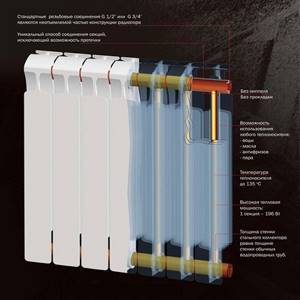
Diagram of a monolithic radiator.
Bimetallic radiators are the most technically advanced heating device for water heating systems. Combining high efficiency and good performance indicators, devices of this type are optimal for use in domestic conditions. Knowing the technical characteristics of bimetallic heating radiators of various models, you can choose a heating device that best suits the operating conditions in a particular room.
Construction of bimetallic heating devices
A bimetallic heating device is indistinguishable in appearance from one made of aluminum. Their main difference is that inside the bimetallic heating device there is a steel body welded from stainless steel, and an aluminum body is installed on top of it.

Construction of bimetallic heating devices
This design ensures that the device will not have contact with the coolant. In addition, steel is much more resistant to the effects of various aggressive substances present in large volumes in centralized thermal energy supply systems. By the way, in some networks, washing is carried out with the addition of a 5% solution of orthophosphoric acid.
The use of steel elements increases the operating life of heating devices. According to some manufacturers, the service life of such structures is up to twenty years.
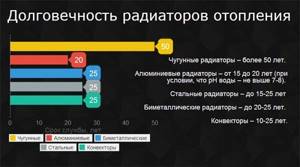
Service life of heating radiators.
The presence of steel inside the bimetallic heating radiator provides significant structural strength. A device of this type can withstand operating pressures of up to 40 atm. Thus, the bimetallic product can withstand serious hydraulic shock.
Narrowed channels guarantee the most effective combination of the thermal inertia of the radiator and the flow rate of the amount of coolant required to heat a given volume.
If we take into account all the properties listed above and add to them high thermal efficiency and a stylish appearance, we can safely say that today bimetallic heating devices are optimal for installation in modern apartment buildings.
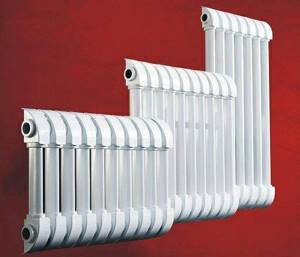
Original design of bimetallic batteries
